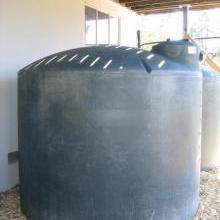Harvesting Rainwater
Harvesting rainwater is an extremely sensible, age old practice that can be approached at nearly any scale. Particularly for irrigation landscape and home garden uses, there is no more ideal water source than rainwater. Household, potable water often has a tremendous amount
No matter where you are in the world:
Home Scale Rainwater Harvesting
Home scale rainwater harvesting has the potential to greatly reduce the overall household cost of irrigating a garden, or landscape plants. The amount of water you can expect to harvest from your own roof will depend very significantly on the square footage of the roof area, and the amount of rain you get.
Consider a modest home, with a 1,000 sq ft roof for example. As referenced above, a 1,000 sq ft area will yield 600 gallons of water for each 1" of rainfall it recieves. The national average rainfall for the US is 39 inches. At the home of Water Wise Supply in our neck of the Bay Area of California we get roughly 24 inches in an average year. 600 gallons per inch x 24 inches of rain gives will yield 14,400 gallons of water.
That's a lot of water! The amount you can harvest from your roof it is often more than most homeowners are prepared to store at once. Tanks take up significant space, and unless you are able to design your water storage int It's quite common then, for folks to only harvest rainwater from 1 or 2 of several gutter downspouts on their home.
It's important to acknowledge here again that your mileage for storage capacity will vary considerably depending on your local annual rainfall. Here in CA, we have a pronounced dry season lasting 8-10 months of the year. And in Northern California our winters can vary from mild to quite wet; so given the amount of time we want to be using that water - it makes sense for us to store as much as possible for summer use. Space constraints make it difficult to store enough water to irrigate even a modest sized garden entirely through a summer in our climate, but often a 5,000 to 10,000 gallon system could supply rainwater to enough vegetables to feed a family of 4 through June or July. That's a considerable amount of water to defer from your rely on the city water supply, and all the energy embedded in that water through the processes of municipal water purification plants.
(we look forward to adding more content to this section, please leave us a note if you want to see more about this)
Rainwater Collection Systems
There are three main ways to use stored rainwater.
1. Gravity drain systems for landscape irrigation
2. Pumped systems for landscape irrigation
3. Pumped systems for indoor use

Rainwater Components
The rainwater catchment system consists of these basic components:
Gutters: Rainwater drains off the roof into gutters and is piped to the storage tank. Gutters are often screened to prevent leaves from entering the gutters.
Pre-filter/screen: The rainwater goes through a screen to remove leaves and debris. Screens can be placed on the gutters, integrated into the gutter downspouts, or be placed on a pipe which drains from multiple downspouts. It is best to place the screen before the first flush as the screen will keep the first flush from clogging.
"First Flush": The water from the first few minutes of each rain event is the dirtiest as it picks up dirt and dust which tends to accumulate on the roof. This water is directed away from the tank in a "first flush diverter" and the subsequent water continues to the tank. Usually 1 gallon is diverted per 100 square feet of catchment area.
Storage: The tank is dark to prevent algae from growing, and screened to prevent mosquitoes from entering.
Pumps and filters: If the rainwater is to be used indoors, or through a drip irrigation system, the rainwater is pumped and filtered to it's final destination (there are gravity based drip irrigation options as well).
Storage Options
 1. In urban areas, rainbarrels are a popular way to begin harvesting rainwater. They can be installed along sides of garages, property lines, under decks, and in other unused spaces.
1. In urban areas, rainbarrels are a popular way to begin harvesting rainwater. They can be installed along sides of garages, property lines, under decks, and in other unused spaces.
 2.Cisterns, or water storage tanks, offer a large capacity for storing rainwater, ranging from hundreds to tens of thousands of gallons. They can be made from plastic, ferrocement, metal, or fiberglass. Cisterns can be placed either above ground or buried below ground.
2.Cisterns, or water storage tanks, offer a large capacity for storing rainwater, ranging from hundreds to tens of thousands of gallons. They can be made from plastic, ferrocement, metal, or fiberglass. Cisterns can be placed either above ground or buried below ground.
 3. A pillow tank (or bladder tank) is an option for small lots where a large above ground or below ground tanks isn't an option. Pillow tanks can be placed under decks or below the house in crawl spaces.
3. A pillow tank (or bladder tank) is an option for small lots where a large above ground or below ground tanks isn't an option. Pillow tanks can be placed under decks or below the house in crawl spaces.
Rainwater Systems
Gravity drain system for landscape irrigation, using a tank or rainbarrel with garden hose
The existing house downspout is redirected to the rainbarrel or tank. The barrel has an overflow to send rainwater out when it is full, and a hose connection near the bottom. When the water is needed, open a valve and rainwater flows out the garden hose. Multiple barrels can be connected together, providing as much storage as there is space for.
Pumped rainwater to drip irrigation
Rainwater can be connected from rainbarrels or a cistern to a drip irrigation system. If the drip irrigation is tubing is at a lower elevation than the cistern, non-pressure compensating drip tubing can be used to apply the rainwater to the landscape using only gravity and manual valves. If automation is required, an irrigation controller can turn on a rainwater pump which supplies water to the landscape through drip irrigation tubing.
Pumped rainwater for indoor use
Rainwater can be used indoors to flush toilets and wash clothes in the laundry machine. Using rainwater indoors makes a lot of sense in urban areas that have long dry summers and wet winters where large storage cisterns would be required to store irrigation water for use during the summer, and irrigation is not required in the winter. Using rainwater indoors requires extra filtration using sediment, carbon and UV light filters.
Water storage: Filtering and Water Quality
The degree to which rainwater needs to be filtered depends upon it's end use and how long the water needs to be stored. For simple rainbarrel systems which use gravity to supply a hose bib, an inlet screen that filters large leaf debris is all that is needed, provided the water is used within a few months. For more complex systems which supply drip irrigation, indoor plumbing fixtures, or for potable uses, the rainwater needs to be filtered to a higher degree.
Pre-filtering: The importance of pre-filtering rainwater before it enters the storage container is often overlooked. Complaints of stored rainwater smelling or turning "rotten" can always be traced to improper pre-filtration. If rainwater is not pre-filtered, a large amount of organic matter in the form of leaves and dirt can enter the storage tank. Aerobic bacteria begin to consume the organic matter and use up all the dissolved oxygen. Anaerobic bacteria begin to predominate resulting in odor. Another benefit of pre-filtering rainwater is reduced sediment buildup at the bottom of the storage tank and less tank maintenance.
There are a variety of options when it comes to prefiltering rainwater. In general, look for filters which are self cleaning to reduce the amount of maintenance needed on the system. The following is a general summary of the most common methods:
Micro-mesh gutter screens: Gutter screens can be installed on the gutter to filter debris before it enters the gutter. One advantage of gutter screening is the large filtering surface area can reduce maintenance of the filter. Some higher quality gutter screening is nearly self cleaning and requires very little maintenance. The micro-mesh screen can filter debris in the 80-100 micron size which is beneficial for potable or indoor fixture systems which require very good filtration.
Downspout Filters: These filters are placed either at the top of the downspout where it meets the gutter, or somewhere along the length of the downspout. These filters generally only provide coarse filtration of 1/8"-1/16" size (3175-1587 microns) and should only be used for rainbarel systems. A few models can filter to 280 microns and make good pre-filters for irrigation systems and indoor non-potable uses.
In Ground Filters/In Tank Filters: These filters are usually buried in the ground or installed in the storage tank and connected to a drain pipe coming from all the downspouts from the building. They are often used for larger roof areas on residential and commercial sites. Filtering size can vary among different models with the best at around 280 microns.
Sand Filters: Sand filters are often used in potable water systems to remove debris from the rainwater before it enters the storage tanks. Sand filters can remove particles up to 30 micron size.
First Flush Diverters: Diverters keep the dirtiest water out of the storage tank and can help reduce sediment accumulation on the bottom of the storage tank. The water from the first few minutes of each rain event picks up dirt and dust which tends to accumulate on the roof. This dirty water is directed away from the storage tank in a "first flush diverter". Usually 1-2 gallon is diverted per 100 square feet of catchment area. Diverters keep the dirtiest water out the the storage tank and can help reduce sediment accumulation on the bottom of the storage tank. Diverters are essential for potable water systems. Particles of air pollution can settle on roofs and and potentially wash into storage tanks without first flush diverters. These particles can be very small and are not easily filtered by sediment or carbon filters.
Landscape Irrigation: Spray irrigation systems need to be filtered to roughly 500-1000 microns, while drip irrigation systems need filtering to 100 microns. If the rainwater has been adequately pre-filtered, a simple irrigation y-filter can achieve the necessary additional filtering for spray or drip irrigation.
Toilet Use: At minimum, a 50 micron sediment filter will prevent grit from interfering with valve mechanisms in the toilet. Often times a carbon filter is utilized to reduce any color or odor that may be present in the water. Many permitting agencies may require filtration to 5 microns and disinfection with chlorine, ozone, or UV light.
Laundry Use: At minimum, a sediment and 5 micron carbon filter should be used to filter rainwater for laundry use. Many permitting agencies may require disinfection with chlorine, ozone, or UV light.
